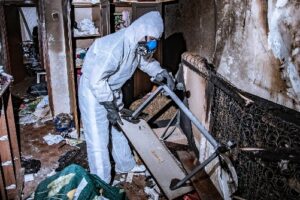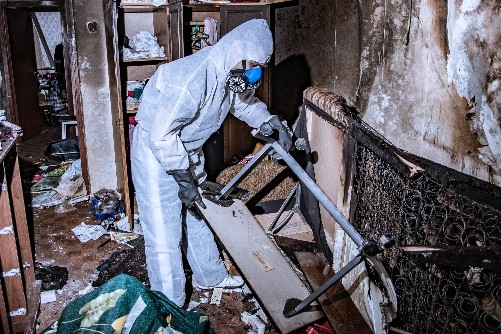Do you Know What Is Fire Damage Restoration? Nobody ever expects to deal with the heartache of a house fire, but the unfortunate reality is that fires are more common than we’d like to think. They can completely upend lives, leaving homeowners with a sense of loss and uncertainty. In the emotional turmoil, it’s essential to remember that there’s a practical pathway to recovery, and that’s where fire damage restoration comes in.

Fire damage restoration is an intricate and specialized undertaking that restores a property after a devastating fire, with the end goal of returning it to its original, pre-fire condition.
The Grim Reality of Fire Damage
According to an alarming report by the National Fire Protection Association, fires resulted in an astounding $21.8 billion in damages across the United States just in the year 2020. The aftermath of a fire isn’t just about burnt walls and a charred framework; it’s also about smoke residues, lingering odors, and a multitude of other issues that need addressing.
Decoding Fire Restoration
When it comes to fire restoration, think of it as a phoenix rising from the ashes. It’s a labor-intensive and highly technical process aimed at reviving your property from the clutches of fire damage. This isn’t a one-size-fits-all operation but a tailor-made solution designed to tackle the unique challenges each fire event poses.
The Heroes Behind the Scenes: Fire Restoration Experts
Contrary to popular belief, not just any handyman can handle fire restoration; it takes a certified Fire and Smoke Damage Restoration Technician to get the job done right. These are the unsung heroes who arrive promptly, sometimes within hours of your emergency call, fully equipped and trained to navigate the complexity of fire damage.
Nuts and Bolts: The Fire Restoration Process
Fire restoration isn’t a quick fix but a layered, multi-step endeavor that requires meticulous planning and execution. Here’s a dive into what typically happens:
Initial Damage Assessment: Professionals enter the property (only after it’s deemed safe by firefighting authorities) to survey the extent of the damage. This informs the subsequent steps of the restoration plan.
Securing the Fortress: Believe it or not, a damaged property can incur more damage post-fire if not properly secured. This usually involves boarding up openings and might also include installing tarps on damaged roofs.
Putting a Lid on Further Damage: The water used to extinguish the fire can be a double-edged sword. While it quashes the flames, it also invites mold and corrosion if not removed promptly.
The Big Clean-Up: This is where elbow grease meets technical precision. From scrubbing off soot stains to neutralizing the haunting smell of smoke, this step is all about detail.
Reconstruction and Final Touches: It’s not just about cleaning but also restoring, whether it’s replacing the wooden floors or repainting the walls.
How Fire Restoration is a League of its Own
While it might be tempting to lump fire restoration with other forms of disaster recovery like flood or tornado damage, the truth is, fire restoration is often more complicated. It involves dealing with different types of damage, from structural integrity to cosmetic issues like soot and staining.
The Financial Factor: Cost of Fire Damage Restoration
Talking money can be awkward, but it’s crucial. Restoration costs can range from a few thousand dollars to astronomical amounts, depending on various factors like the size of the property and the extent of the damage. Most importantly, it’s prudent to check with your insurance provider to understand the scope of your coverage.
Is Investing in Fire-Damaged Properties Worth It?
When it comes to real estate investment opportunities, fire-damaged properties can be a double-edged sword. While some see it as an insurmountable challenge, others view it as a diamond in the rough, especially if the numbers add up.
Real-Life Scenarios
For instance, take the case of a Memphis-based investor, Paul Schaefer, who stumbled upon a potential gold mine—a fire-damaged property listed on the MLS for just $5,900. Located in a fairly decent area near the University of Memphis, the 1,392 sqft property was a 2-bedroom, 1-bath house with an after-repair value (ARV) that could easily surpass $100,000. This led him to ponder the essential question: “Is fire damage worth it?”
Expert Opinions
Investor Peter Sanchez, based in Washington DC, suggests that a property with fire damage is much like any other—remove the damaged parts and replace them with new ones. According to Sanchez, it boils down to assessing the total cost, including demolition and new construction.
Jeremy VanDelinder, a rehabber from Round Rock, Texas, offers another layer to the argument. He runs a fire damage restoration company and has flipped fire-damaged properties. He emphasizes that the profit margins can be lucrative if—and it’s a big ‘if’—you’ve done thorough due diligence. He points out that fire damage often comes hand-in-hand with water and potentially mold damage, complicating the restoration process.
Challenges and Risks
John Woodrich, a seasoned flipper from Minneapolis, adds a word of caution. He suggests that without concrete numbers, especially in the case of extensive fire damage, the ARV of $100,000 might not leave much room for profit.
Nick Gann, a real estate agent from Murfreesboro, Tennessee, further cautions that the hidden costs could lie in the electrical system, mold, or even city permits and inspections. “You have to figure out what you don’t know,” says Gann, emphasizing the importance of exhaustive research.
Conclusion
Life after a fire can be overwhelmingly challenging, but the good news is, you don’t have to go it alone. Certified professionals in fire damage restoration can take the reins, guiding you through a process that is as thorough as it is compassionate. They understand that they’re not just restoring homes—they’re restoring lives.
FAQ Section About What Is Fire Damage Restoration?
What’s the very first thing that happens in fire damage restoration?
The immediate first step is a thorough assessment to determine the extent of the damage, which serves as a blueprint for the entire restoration journey.
How long should I expect the fire restoration to take?
There’s no straightforward answer as it can take weeks to months, depending on factors like the scale of the fire and the resources required for restoration.
What credentials should a fire restoration professional hold?
Ideally, you want to hire someone certified as a Fire and Smoke Damage Restoration Technician, as they possess the required skills and experience.
What can I do to prevent additional damage post-fire?
Removing excess water and securing the property against unauthorized entry and weather elements are crucial steps in preventing further damage.
Is fire restoration usually covered by insurance?
Most homeowner insurance policies do provide some level of coverage, but it’s always best to consult your individual policy for specifics.

